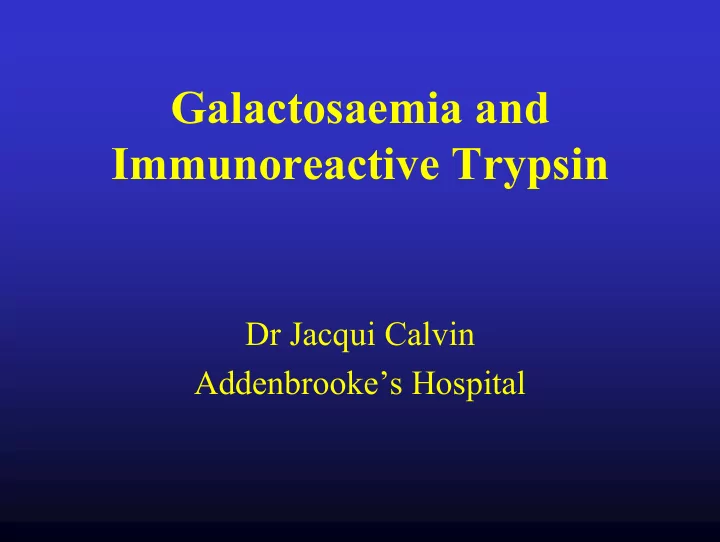

Galactosaemia and Immunoreactive Trypsin Dr Jacqui Calvin Addenbrooke’s Hospital
Raised serum or dried bloodspot immunoreactive trypsin (IRT) may occur in:- Occlusion of pancreatic ductules/ducts Hyperconcentration of ductular fluid (for example in Cystic Fibrosis where the Cystic Fibrosis Transmembrane Regulator (CFTR) is defective) Exocrine pancreatic inflammation/necrosis
• In infancy raised serum or bloodspot IRT is a characteristic finding in Cystic Fibrosis • Used as the basis of newborn screening programmes for CF
IRT is not ideal! • Newborns have higher values of IRT than adults • Values decrease to adult levels by about 6 wks of age • Most babies with CF (~98%) will have raised values of IRT on days 5-8
• When tested on days 5-8 there is overlap between unaffected babies and CF babies • Therefore a second step is added to the screening process. This can be a second IRT, a DNA test or a combination of both • In CF babies the IRT remains elevated when retested at approximately 4 wks of age
Day 6-14 sample IRT in singleton IRT greater than 60 µ g/L IRT less than 60 µ g/L Re-assay in duplicate Average greater than Average less than 70 µ g/L Report CF Not Suspected 70 µ g/L Repeat Blood Sample Requested Assay in duplicate Average greater than Average less than 60 µ g/L Report CF Not Suspected 60 µ g/L Blood spot tested for common mutation, Clinical referral & Sweat test if indicated
IRT day 5-8 IRT-DNA-IRT IRT <60 ug/L IRT >60 ug/L Protocol CF NOT SUSPECTED Repeat in duplicate IRT <70 ug/L IRT >70 ug/L Mutation Analysis DF 508 Negative 1 or 2 DF 508 DF 508 not detected mutations detected If initial IRT <90 ug/L If initial IRT >90 ug/L 29 mutation panel Second card for IRT day 27 including DF 508 Second IRT <60 ug/L Second IRT >60 ug/L 1 mutation detected 2 mutations detected CF not suspected Probable CF Second card for IRT CF Report to paediatrician day 27 Report to paediatrician Second IRT <60 ug/L Second IRT >60 ug/L CF not suspected Probable CF Probable carrier Report to paediatrician
Non-CF causes of raised IRT Faecal contamination of the bloodspot card ∆ F508 heterozygotes Spina bifida Hypoxic insult to pancreas Gastroschisis Renal insufficiency Viral infections Congenital heart disease Trisomies 13, 18 Nephrogenic DI Mechanisms not always clear!
Serum IRT in galactosaemia 15 / 19 galactosaemics had raised IRT ULN � � Abnormal FTT Delayed Galactosaemics Other IMDs LFTs passage meconium
• Raised IRT was not seen in other inherited metabolic disorders with renal Fanconi syndrome, including those with liver damage (Wilson’s, tyrosinaemia type 1) – intracellular trapping of phosphate is not a feature of these disorders • However number of cases very small
Serum IRT pre and post treatment in galactosaemia
sIRT Pre and post treatment
Biochemical results Patient A At diagnosis Post treatment Bilirubin ( µ mol/L) 325 139 ALP (IU/L) 2648 1378 ALT (IU/L) 467 139 Phe ( µ mol/L) 357 normal Tyr ( µ mol/L) 923 523 Met ( µ mol/L) 90 normal Amino aciduria gross normal IRT ( µ g/L) 181 normal
Biochemical results At diagnosis Post treatment Patient B Amino aciduria Gross Mild IRT ( µ g/L) 175 Normal Patient D Amino aciduria Gross Normal IRT ( µ g/L) 130 Normal Patient E Amino aciduria Gross Normal IRT ( µ g/L) 200 Normal
CFTR Large number of the more common mutations are located in the nucleotide binding folds of the protein Normal function is dependent on the adequate supply of ATP for phosphorylation of the regulator domain and allosteric binding of ATP to the nucleotide domains. Also Na + /K + ATPase required to maintain the electrochemical gradient for Cl - to exit the apical membrane
According to “Scriver” “Modest inhibition of mitochondrial ATP synthesis, even with small changes in tissue ATP, will disrupt transport processes.” Do conditions which depress the ATP pool affect the action of CFTR and mimic the pathophysiology in CF??
Babies in intensive care Day 1 Guthrie’s undertaken (paper chromatography of amino acids) Observed that babies with raised alanine (usually related to hypoxia) had raised IRTs.
Unexplained lactic acidosis Female infant aged 4m Failure to thrive, steatorrhoea, renal tubular acidosis Raised IRT, normal sweat test, negative for common CF mutations Plasma lactate = 5.5 mmol/ l CSF lactate = 4.2 mmol/L
Age 9m – viral gastroenteritis triggered seizures and encephalopathy Raised IRT persisted CT scan: Mild diffuse atrophy affecting brain stem, cerebellum and cerebrum
Respiratory chain enzyme complexes normal (muscle biopsy) Fibroblast pyruvate dehydrogenase assay repeatedly just below the reference range (?PDH heterozygosity)
Summary Serum IRT concentrations in untreated galactosaemia are comparable to those seen in CF Values may be normal prior to development of acute symptoms and signs IRT rapidly declines with dietary treatment The decline mirrors improving amino aciduria rather than acute markers of liver disease
Is energy-deficit the common link between the observed renal absorption defect and the raised sIRT in galactosaemia?
Recommend
More recommend